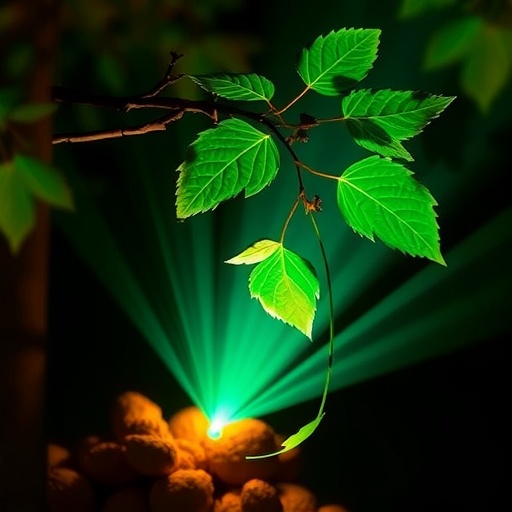Physicists at Umeå University, in collaboration with experts based in China, have announced a groundbreaking advance in laser technology: the creation of a fully biomaterial-based random laser, engineered entirely from birch leaves and peanut kernels. This innovation represents not only a remarkable stride toward sustainable and environmentally friendly photonics, but also opens exciting avenues for practical applications in medical diagnostics, imaging, and authentication technologies. The research, published in the prestigious journal Nanophotonics, showcases how common, renewable natural materials can be transformed through simple processing techniques into complex optical devices that rival their synthetic counterparts.
Random lasers stand apart from conventional lasers due to their unique operational principles. Rather than relying on a precisely structured optical cavity to amplify light in a coherent, directional beam, random lasers exploit multiple scattering events within disordered media, producing intense yet spatially diffuse emission. This scattered laser light holds tremendous promise for biomedical purposes because it can homogeneously illuminate biological tissues, enabling detailed imaging without causing localized tissue damage. Despite a surge in interest over the past decade, the majority of random lasers depend on synthetic materials that either carry environmental toxicity risks or demand costly and intricate manufacturing processes.
The team at Umeå University sought to transcend these limitations by turning to nature’s abundant materials. They developed a novel approach utilizing nanometre-sized carbon dots derived from birch leaves, a remarkably straightforward and green synthesis achieved through a single-step pressure-cooking method. These carbon dots serve as the gain medium that provides the necessary optical amplification. Complementing this, they employed peanut kernels, finely cut into small cubes whose rugged and irregular surfaces efficiently trap and scatter incident light. The intrinsic microstructure of the peanut kernels, untouched by complex fabrication, creates the disordered scattering environment crucial for the laser’s operation.
In operation, the laser requires external optical excitation but critically, all functional scattering and amplifying components arise solely from natural biomaterials. This device embodies a new paradigm in optoelectronics where high-performance functionalities are realized via sustainable feedstocks, bypassing conventional reliance on rare earth elements or toxic compounds. Impressively, energy characterization experiments revealed that the biomaterial-based laser’s threshold and emission quality equaled those found in many artificially engineered random lasers, underpinning its practical viability.
Beyond its performance metrics, the implications of this development are far-reaching. Jia Wang, Associate Professor at Umeå University and lead author of the study, expressed enthusiasm that besides applications in bioimaging and early disease detection, the biomaterial laser’s low cost, biocompatibility, and renewability render it an excellent candidate for novel anti-counterfeiting measures. This could include optical tagging for high-value products such as documents, luxury goods, and even electronic devices, offering a secure and ecologically responsible method of verification that minimizes environmental impact.
This research builds on Jia Wang’s group’s longstanding commitment to harnessing locally available renewable resources for advanced technological applications. Prior studies by the group demonstrated the conversion of birch leaves collected from the university campus into organic semiconductors, materials integral to flexible displays found in contemporary televisions and smartphones. The current advance in biomaterial lasers marks a significant leap, bridging nanophotonics and sustainable materials science in a way that aligns perfectly with modern environmental imperatives.
Fundamentally, random lasers achieve their distinctive diffuse emission through numerous scattering events within an optically disordered medium. Unlike the directional beams from classical semiconductor or fiber lasers, the randomized light paths ensure broad-area illumination, vital for medical imaging tasks such as tissue analysis and early pathology detection. Previous biomaterial-based random lasers have been demonstrated using components like abalone shells or coral skeletons combined with biological pigments such as chlorophyll. However, the integration of birch leaf carbon dots with peanut kernel scaffolds represents a completely novel biomaterial combination, with improved ease of synthesis and scalability.
The technical simplicity of the carbon dot formation—utilizing pressure and heat in a one-step process without the need for sophisticated equipment—makes the approach exceptionally accessible. This method facilitates the production of highly fluorescent carbon dots with tunable optical properties suitable for random lasing. Meanwhile, the peanut kernels’ physical topology provides an ideal natural counterpart for light scattering, negating the need for artificial microstructuring or lithography, historically costly steps in photonic device fabrication.
Researchers demonstrated the lasing action under laser excitation, with the system emitting coherent light despite the absence of a traditional optical cavity. Under daylight illumination, the biomaterial laser remains visually distinct, reinforcing its stability and robustness under various lighting conditions. These empirical observations confirm both the functional integrity and environmental adaptability of the system, essential for real-world deployment.
Looking forward, the team envisions expanding the range of biomaterial constituents, optimizing light emission wavelengths, and enhancing device integration for portable medical diagnostic tools. The fusion of sustainable materials science with advanced photonics heralds a transformative future in which high-performance optical devices are no longer environmentally burdensome but instead contribute synergistically to a greener technological ecosystem.
This pioneering work not only underscores the untapped potential of biomaterials in cutting-edge physics but also challenges prevailing paradigms by demonstrating that simplicity and nature-derived materials can produce sophisticated and highly functional lasers. As global focus sharpens on sustainability and green innovation, such advances illuminate a path toward environmentally harmonious photonic technologies profoundly impacting healthcare, security, and communications.
Subject of Research:
Article Title: Biomaterial-based random lasers achieved from peanut kernel doped with birch leaf–derived carbon dots
News Publication Date: 10-Sep-2025
Web References: http://dx.doi.org/10.1515/nanoph-2025-0312
Image Credits: Zhihao Huang
Keywords
Physics, Laser physics, Materials engineering, Technology
Tags: biomaterial-based random lasersbirch leaves in photonicsenvironmental impact of lasersimaging technologies using lasersinnovative applications of random lasersmedical diagnostics with lasersnon-toxic laser materialspeanut kernels in opticsrenewable materials in technologysimple processing techniques for laserssustainable laser technologyUmeå University laser research





